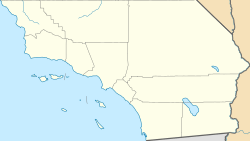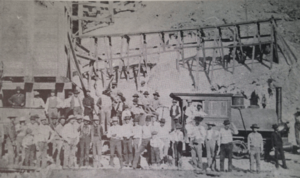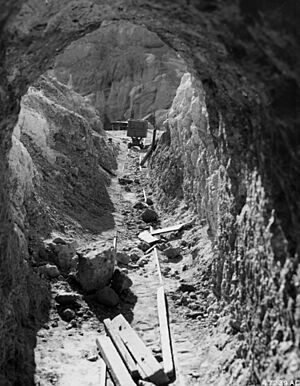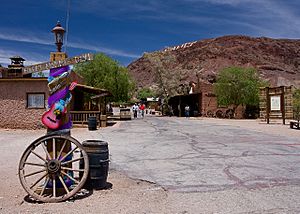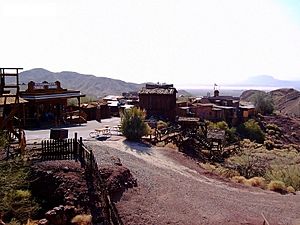Calico, California facts for kids
Quick facts for kids
Calico
|
|||||||||
|---|---|---|---|---|---|---|---|---|---|
|
|||||||||
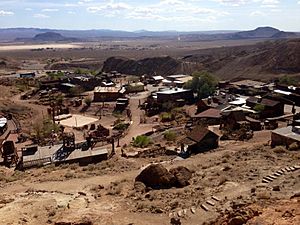
Calico in the Mojave Desert
|
|||||||||
| Country | United States | ||||||||
| State | California | ||||||||
| County | San Bernardino | ||||||||
| Elevation | 2,283 ft (696 m) | ||||||||
| Time zone | UTC−8 (Pacific) | ||||||||
| • Summer (DST) | UTC−7 (PDT) | ||||||||
| ZIP code |
92398
|
||||||||
| Area codes | 760/442 | ||||||||
| GNIS feature ID | 1660414 | ||||||||
|
|||||||||
Calico is a famous ghost town and a former mining town located in San Bernardino County, California. It sits in the Calico Mountains within the Mojave Desert region of Southern California. The town was started in 1881 because of a big silver discovery.
Today, Calico is a county park known as Calico Ghost Town. You can find it off Interstate 15, about 3 miles (5 km) from Barstow and Yermo. Large letters spelling CALICO are visible from the highway on the Calico Peaks behind the town. In the 1950s, Walter Knott (who founded Knott's Berry Farm) bought Calico. He rebuilt most of the town to look like it did in the 1880s, keeping five original buildings. Calico is recognized as California Historical Landmark #782. In 2005, it was officially named California's Silver Rush Ghost Town by Governor Arnold Schwarzenegger.
Contents
Discovering Silver: Calico's Early Days
In 1881, four explorers were traveling near what is now Barstow, California. They saw a mountain peak that looked "calico-colored," meaning it had many different colors. Because of this, the peak, the mountain range, and the town that grew there were all named Calico.
These four explorers found a lot of silver in the mountain. They opened the Silver King Mine, which became California's biggest silver producer in the mid-1880s. John C. King, who helped fund these explorers, was the uncle of Walter Knott.
Life in a Busy Mining Town
A post office opened in Calico in early 1882. Soon after, a weekly newspaper called the Calico Print began publishing. The town quickly grew to have three hotels, five general stores, a meat market, bars, and several restaurants and boarding houses. It also had a school, a voting place, a deputy sheriff, and doctors. A Wells Fargo office, along with telephone and telegraph services, made communication easier.
At its busiest, between 1883 and 1885, Calico had over 500 mines and about 1,200 people living there. People who caused trouble were buried in the Boot Hill cemetery.
From Silver to Borate: Calico's Changing Fortunes
A few years after silver was discovered, the mineral colemanite (a type of borate) was also found in the Calico mountains. This helped the town grow even more. By 1890, Calico's population was estimated to be 3,500 people. Many different nationalities lived there, including people from China, England, Ireland, Greece, France, and the Netherlands, alongside Americans.
However, in 1890, a law called the Sherman Silver Purchase Act caused the price of silver to drop. By 1896, silver was worth so little that Calico's silver mines were no longer profitable. The post office closed in 1898, and the school followed soon after. By the early 1900s, Calico was almost a ghost town. When borax mining also ended in 1907, the town was mostly abandoned. Many of its original buildings were moved to nearby towns like Barstow and Yermo.
Bringing Calico Back to Life: Walter Knott's Vision
Around 1915, there was an attempt to bring Calico back. A special plant was built to get silver from old mine deposits. Walter Knott, who later founded Knott's Berry Farm, helped build parts of this plant.
Years later, in the 1940s, Walter Knott built a "Ghost Town" at his theme park. This experience made him think about restoring a real ghost town. In 1951, Walter Knott bought Calico from the Zenda Mining Company. He put his art director, Paul von Klieben, in charge of restoring the town to its original look, using old photographs as guides.
Knott spent a lot of money, about $700,000, to restore Calico. He even hired a longtime employee, Freddy "Calico Fred" Noller, to live there and greet visitors. In 1966, Walter Knott gave the town to San Bernardino County, and it became a County Regional Park.
Calico Today: A Historic Park for Visitors
Today, Calico looks like it did during the exciting silver rush era. While some original buildings were moved, many have been restored or rebuilt to match the old style. Most of the buildings are made of wood, with a simple, rustic look.
Some buildings still standing from the town's active years include Lil's Saloon, the town office, and the general store. Lucy Lane's former home, which was once the post office and courthouse, is now the main museum. There's also a replica of the schoolhouse built where the original one stood. Only ruins remain of the homes where Chinese citizens once lived.
Calico's Official Recognition
In November 1962, Calico Ghost Town was named a California Historical Landmark (#782). For a while, Calico and Bodie (another famous ghost town) both wanted to be named the Official State Ghost Town. In 2005, a compromise was reached. Bodie became the Official State Gold Rush Ghost Town, and Calico became the Official State Silver Rush Ghost Town.
Fun Things to Do at Calico Ghost Town
Today, Calico offers many activities for visitors. You can take mine tours, watch exciting gunfight stunt shows, and try gold panning. There are several restaurants and a historic narrow-gauge train ride called the Calico and Odessa Railroad. You can also explore a Mystery Shack and browse many souvenir shops.
Calico Ghost Town is open every day except Christmas. There is an entrance fee, and some attractions cost extra. You can even camp overnight. Throughout the year, special events are held, such as Civil War Days, a Spring Festival, Calico Days, and a Ghost Town haunt around Halloween. The Calico Cemetery, which has many graves, has had burials even in recent times.
See also
 In Spanish: Calico (California) para niños
In Spanish: Calico (California) para niños


